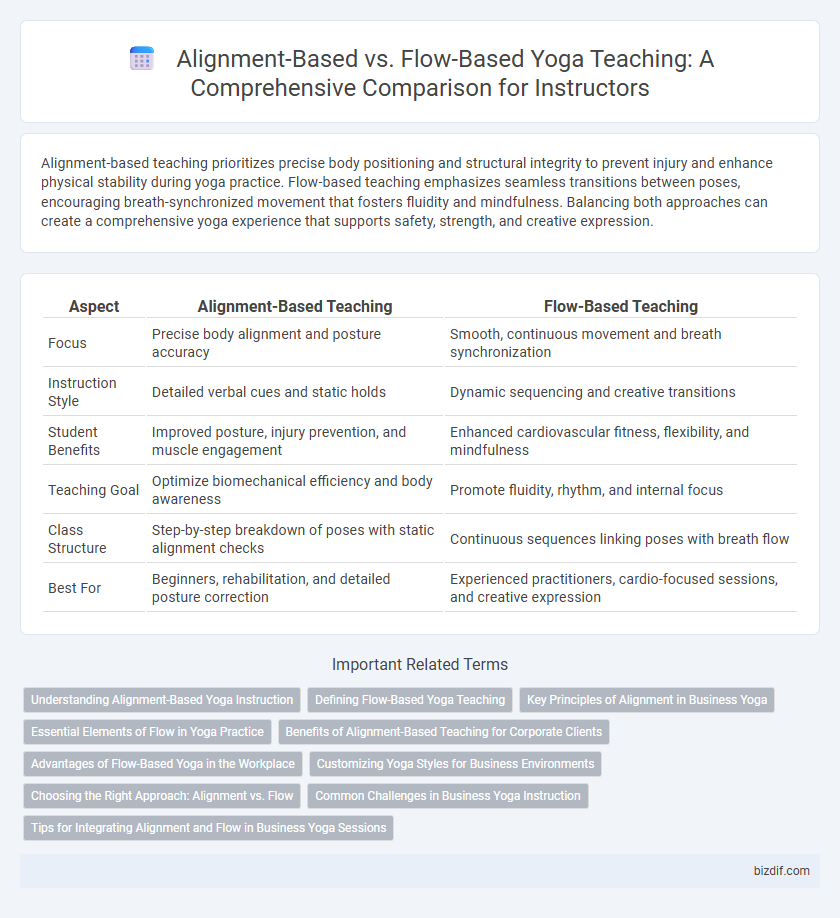Alignment-based teaching prioritizes precise body positioning and structural integrity to prevent injury and enhance physical stability during yoga practice. Flow-based teaching emphasizes seamless transitions between poses, encouraging breath-synchronized movement that fosters fluidity and mindfulness. Balancing both approaches can create a comprehensive yoga experience that supports safety, strength, and creative expression.
Table of Comparison
| Aspect | Alignment-Based Teaching | Flow-Based Teaching |
|---|---|---|
| Focus | Precise body alignment and posture accuracy | Smooth, continuous movement and breath synchronization |
| Instruction Style | Detailed verbal cues and static holds | Dynamic sequencing and creative transitions |
| Student Benefits | Improved posture, injury prevention, and muscle engagement | Enhanced cardiovascular fitness, flexibility, and mindfulness |
| Teaching Goal | Optimize biomechanical efficiency and body awareness | Promote fluidity, rhythm, and internal focus |
| Class Structure | Step-by-step breakdown of poses with static alignment checks | Continuous sequences linking poses with breath flow |
| Best For | Beginners, rehabilitation, and detailed posture correction | Experienced practitioners, cardio-focused sessions, and creative expression |
Understanding Alignment-Based Yoga Instruction
Alignment-based yoga instruction emphasizes precise body positioning to enhance safety, prevent injuries, and deepen physical awareness during practice. This method prioritizes anatomical accuracy, guiding students to engage muscles correctly and optimize joint function. Understanding alignment-based teaching helps practitioners build a strong foundation, improving overall body mechanics and supporting sustainable progress in yoga.
Defining Flow-Based Yoga Teaching
Flow-based yoga teaching emphasizes continuous, dynamic movement synchronized with breath, fostering an organic connection between postures rather than static holds. This method prioritizes fluid transitions and rhythm to enhance cardiovascular endurance, flexibility, and mind-body awareness. In contrast to alignment-based approaches, flow-based instruction allows adaptive sequencing that responds to students' energy levels and emotional states.
Key Principles of Alignment in Business Yoga
Key principles of alignment in business yoga emphasize maintaining anatomical precision to prevent injury and enhance posture efficiency during practice. Instructors prioritize joint stacking, muscle engagement, and spinal alignment to promote physical stability and mental clarity for professionals. This method contrasts with flow-based teaching by focusing on deliberate positioning rather than fluid movement, catering to workplace wellness through structured, mindful poses.
Essential Elements of Flow in Yoga Practice
Essential elements of flow in yoga practice emphasize smooth transitions, synchronized breath, and continuous movement to cultivate mindfulness and bodily awareness. Alignment-based teaching prioritizes precise postural integrity, ensuring safety and effectiveness, while flow-based teaching focuses on dynamic sequencing that promotes fluidity and energetic connection. Integrating breath control, rhythm, and intentional movement enhances the overall experience, fostering a balanced and harmonious yoga practice.
Benefits of Alignment-Based Teaching for Corporate Clients
Alignment-Based Teaching enhances body awareness and reduces injury risks by emphasizing precise postures, which is crucial for corporate clients who often experience desk-related strain. This approach improves posture, alleviates tension in the neck, shoulders, and back, and promotes long-term musculoskeletal health, boosting overall workplace productivity. Structured alignment techniques also foster mindfulness and stress reduction, helping employees maintain focus and resilience in high-pressure environments.
Advantages of Flow-Based Yoga in the Workplace
Flow-based yoga in the workplace enhances employee flexibility and reduces stress by promoting continuous movement that adapts to individual energy levels. This dynamic approach fosters mental clarity and creativity, improving overall productivity and focus during work hours. Integrating flow-based yoga sessions supports a resilient workforce by balancing physical exertion with mindful breathing techniques.
Customizing Yoga Styles for Business Environments
Alignment-based teaching emphasizes precise postures and anatomical correctness, ensuring safety and injury prevention in corporate yoga sessions. Flow-based teaching prioritizes fluid movement and breath synchronization, promoting stress relief and mental clarity suited for dynamic office settings. Customizing yoga styles by integrating alignment precision with flowing sequences can enhance employee well-being and productivity in diverse business environments.
Choosing the Right Approach: Alignment vs. Flow
Choosing the right approach between alignment-based teaching and flow-based teaching depends on the student's experience level and individual goals. Alignment-based instruction emphasizes precise postural details and anatomical safety, ideal for beginners or those recovering from injury. Flow-based teaching prioritizes breath-synchronized movement and fluid transitions, benefiting practitioners seeking a dynamic, meditative practice.
Common Challenges in Business Yoga Instruction
Alignment-based teaching emphasizes precise postural alignment to prevent injury and optimize physical benefits, yet instructors often face challenges in balancing detailed cues with maintaining class engagement. Flow-based teaching prioritizes smooth transitions and rhythm, which can complicate maintaining student safety and alignment awareness during dynamic sequences. Both approaches require educators to adapt communication and sequencing strategies to accommodate diverse student abilities and expectations in a business yoga setting.
Tips for Integrating Alignment and Flow in Business Yoga Sessions
Incorporate alignment cues within a fluid sequence to maintain both structural integrity and dynamic movement during yoga sessions. Emphasize mindful transitions that support joint safety while encouraging continuous breath and energy flow. Utilize verbal prompts and hands-on adjustments to blend precision with rhythm, enhancing the overall practitioner experience in business yoga classes.
Alignment-Based Teaching vs Flow-Based Teaching Infographic

 bizdif.com
bizdif.com